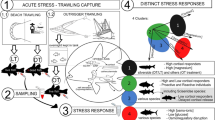Abstract
Grey mullet (Mugil cephalus) juveniles were subjected to salinity stress in order to determine physiological response and recovery. Variations in the most important blood physiological indicators of stress (i.e., cortisol and glucose) were analyzed after application of stress. According to the results, the concentration of cortisol increased significantly 30 min after delivery of fish to water with 15 and 25 ppt salinities. The elevated levels of cortisol returned to basal levels 60 min after application of stress (P > 0.05). Plasma cortisol and glucose did not show significant changes after delivery of fish to water with 35 ppt salinity (P > 0.05). The elevation of plasma glucose occurred 30 and 60 min after delivery of fish to water with 15 and 25 ppt salinities (P > 0.05). Our study demonstrated that low salinities are stressful for grey mullet juveniles.






Similar content being viewed by others
References
Barton B, Iwama G (1991) Physiological changes in fish from stress in aquaculture with emphasis on the response and effects of corticosteroids. Ann Rev Fish Dis 1:3–26
Barton B (2002) Stress in fishes: a diversity with particular reference in changes in circulating corticosteroids. Integr Comp Biol 42:517–525
Barton BA, Morgan JD, Vijayan MM (2002) Physiological and condition-related indicators of environmental stress in fish. In: Adams SM (ed) Biological indicators of aquatic ecosystem stress. American Fisheries Society, Bethesda, pp 111–148
Carragher JF, Rees CM (1994) Primary and secondary stress responses in golden perch Macquaria ambigua. Comp Biochem Physiol 107A:49–56
Dethloff GM, Schlenk D, Khan S, Bailey HC (1999) The effects of copper on blood and biochemical parameters of rainbow trout (Oncorhynchus mykiss). Arch Environ Contam Toxicol 36:415–423
Donald E, Portz AE, Christa M, Woodley AE, Joseph J, Jr C (2006) Stress-associated impacts of short-term holding on fishes. Rev Fish Biol Fish 16:125–170
Fevolden SE, Roed KH, Fjalestad KT (2002) Selection response of cortisol and lysozyme in rainbow trout and correlation to growth. Aquacul 205:61–75
Jamalzadeh HR, Akhundian M, Kabir M, Khara H, Mirrasuli E, Hajirezaee S, Golpour A (2013) Changes of gonadosomatic index and plasma levels of cortisol in the male and female captive Caspian brown trout, Salmo trutta caspius (Kessler, 1877) during the reproductive cycle. J Appl Anim Res 41:133–136
Mazeaud MM, Mazeaud F (1981) Adrenergic responses to stress in fish. In: Pickering AD (ed) Stress and fish. Academic, New York, pp 49–75
Mommsen TP, Vijayan MM, Moon TW (1999) Cortisol in teleosts: dynamics, mechanisms of action, and metabolic regulation. Rev Fish Biol Fish 9:211–268
Ortuno J, Esteban A, Meseguer J (2002) Lack of effect of combining different stressors on innate responses of sea bream (Sparus aurata L.). Vet Immunol Immunopathol 84:17–27
Pickering AD, Pottinger TG (1989) Stress responses and disease resistance in salmonid fish: effects of chronic elevation of plasma cortisol. Fish Physiol Biochem 7:253–258
Randall DJ, Perry SE (1992) Catecholamines. In: Hoar WS, Randall DJ (eds) Fish physiology, vol 12B. Academic Press, New York, pp 255–300
Saplosky RM, Romero LM, Munck AU (2000) How do glucocorticoids influence stress response? Integrative, permissive, suppressive, stimulatory, and preparative actions. Endocr Rev 21:55–89
Vijayan MM, Pereira CE, Grau G, Iwama GK (1997) Metabolic responses associated with confinement stress in tilapia: the role of cortisol. Comp Biochem Physiol 116:89–95
Wendelaar Bonga SE (1997) The stress response in fish. Physiol Rev 77:591–625
Acknowledgments
The authors express their sincere appreciation to Offshore Fisheries Research Center, Chabahar, Iran, for providing of fish and facilities for this study.
Author information
Authors and Affiliations
Corresponding author
Rights and permissions
About this article
Cite this article
Mohamadi, M., Bishkoul, G.R., Rastiannasab, A. et al. Physiological indicators of salinity stress in the grey mullet, Mugil cephalus, Linnaeus, 1758 juveniles. Comp Clin Pathol 23, 1453–1456 (2014). https://doi.org/10.1007/s00580-013-1804-7
Received:
Accepted:
Published:
Issue Date:
DOI: https://doi.org/10.1007/s00580-013-1804-7




